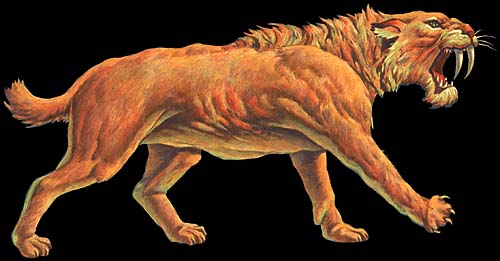
Effect of Mass Extinctions on Evolution
Mass extinctions clearly lead to major changes in direction of the general pattern of evolution. For example, the K/T Event killed off the highly successful dinosaurs and made possible the rise of mammals. Mammals had led a marginal existence for millions of years before the event and it seems unlikely that they would have emerged as the dominant large animal type without this help.
Does this mean that the direction of evolution is random, with unpredictable changes of direction at each mass extinction? Would the earth never have involved a species intelligent enough to ask about its origins, without the K/T Event??? And is the evolution of similar intelligence elsewhere determined by rolling the dice in this same way? There is debate over the answers. The question is whether evolution takes the same path, more or less, given the same conditions, or whether this path is largely random. To understand this issue further, we discuss "convergent evolution."
Convergent Evolution
| Similar features in different animals often arise because they have evolved from a feature in a common ancestor. An example is the forelimb of mammals. (Illustration from http://www.ucmp.berkeley.edu/) |  |
| Evolution can also work to produce similar solutions to similar
problems for survival, without those solutions being derived from the same ancestor. The
figure to the right compares the wing of a pterodactyl (a
flying reptile), a bird, and a bat (a mammal). These structures appear to originate
independently, both because they are from quite different classes of animal and from
examining their details. Thus, in the pterodactyl, the wing membrane is supported by the
5th finger of the forelimb, in the bird by the 2nd finger, and in the bat, by the 3rd, 4th
and 5th fingers. (Illustration from http://www.ucmp.berkeley.edu/) All three structures evolved from the forelimbs of the ancestors of these animals, but evidently along different routes. However, the problems of flying for large animals (that is, larger than insects) are the same, independent of the animal. Thus, the variety of solutions is limited and all three of the flyers to the right evolved nearly identical ones. This process is known as convergent evolution. |
 |
However, evolution does not always converge to similar solutions.
 |
South America was isolated from other large land masses for millions
of years following the K/T event, and a large flightless bird, the Phorusrhacos, evolved
to become the dominant predator. These fearsome creatures were 6 - 10 feet tall.
(left from http://www.bbc.co.uk/beasts/evidence/prog5/page6.shtml right from http://www.ucmp.berkeley.edu/vertebrates/flight/aves.html
|
 |
 |
At the same time, in the merged Africa-Europe-Asia-North America, large cats were the dominant predators, such as this Smilodon (Saber Tooth) that ruled North America. Smilodons were about 5 feet long and 3 feet high. (From Joe Tucciarone, http://prehistoricsillustrated.com/pg_jtu_39.html) When plate motions carried South America into contact with North America, the cats invaded and took over top spot. The Phorushacos also invaded North America, but eventually became extinct. Eventually the saber tooths also died out, but large cats remain the most powerful predators in both North and South America. |
So we reach a wishy-washy conclusion. Mass extinctions and other major challenges to evolution frequently lead to similar solutions - convergent evolution - starting from dis-similar organisms, but there are also examples where such events set things off in new and different directions in a somewhat random fashion.
|

Rodin's "The Thinker", from Cleveland Museum of Art, http://www.clevelandart.org/educef/rodin/html/index.html |
|
Click to return to syllabus |
||
| Click to return to Mass Extinctions | hypertext |
Click to go to Intelligence |